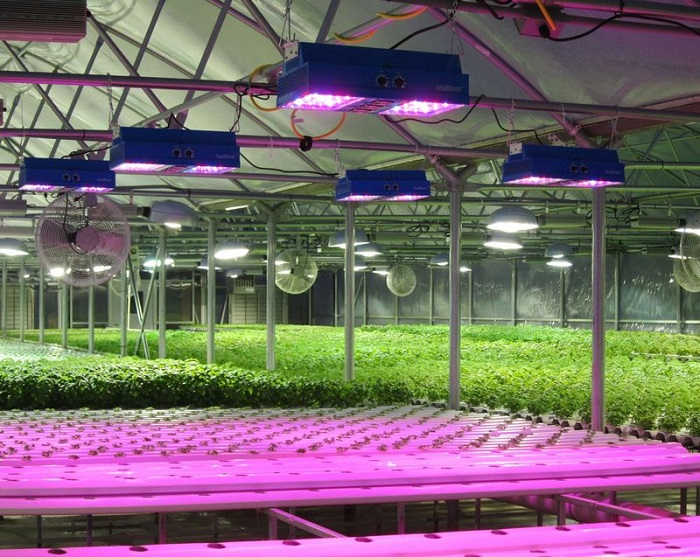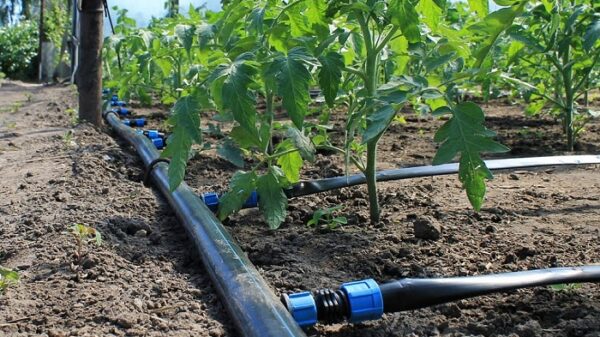In today’s world, technology does not stand still. A special place in this series is occupied by LED technologies, which are used in a variety of fields — from home lighting to industrial complexes. However, phyto-LEDs deserve special attention — unique light sources designed specifically for the needs of plants.
Content
- What are phytoLEDs?
- The production process and the role of the phosphor.
- The effect of phosphor on the color of the glow.
- Types of phytodiodes and their spectra.
- Which white spectra are suitable for plants?
- Spectra of LEDs and stages of plant growth.
- Conclusion.
1. What are phytoLEDs?
PhytoLEDs are specialized LED lamps designed to stimulate plant growth and development. They differ from traditional LEDs in that they emit light in certain wavelength ranges that are most useful for plant photosynthesis.
The word «phyto» comes from the Greek «phyto-«, which means «plant». Thus, phyto-LEDs are specially designed for plants, trying to bring the light spectrum closer to the one that is ideal for crop production.
Here are some key features of phytoLEDs:
- Specific light spectrum: PhytoLEDs typically emit light in the red and blue spectra that are essential for photosynthesis. Red light promotes stem growth and flowering, while blue light stimulates leaf growth.
- Energy efficiency: These LEDs are energy efficient and can last for a long time without overheating, making them ideal for growing plants indoors.
- No harmful radiation: PhytoLEDs do not emit ultraviolet or infrared radiation, which can be harmful to plants or humans.
- Flexibility in use: they can be used as an additional light source in dark rooms, as well as the main light source for hydroponic systems or growing plants indoors.
In conditions where natural light is limited or absent, phyto-LEDs become an indispensable assistant for any gardener striving for the health and beauty of their plants.
2. Production Process and Role of Phosphor
The production of phytoLEDs is a technological process in which one of the key components is the use of phosphors. To understand the importance of phosphors in this context, you first need to understand their nature and function.
What is a phosphor?
A phosphor is a substance capable of absorbing light energy in one wavelength range and emitting it in another, often visible, range. This process is called luminescence.
The production process of phyto-LEDs
- Selection of the appropriate semiconductor material. LEDs are based on semiconductor materials that emit light when activated. Generally, an LED that emits blue light and is coated with a phosphor is used to create white light.
- Application of phosphor. The blue light emitted by the LED is absorbed by the phosphor, which in turn emits light of a different color, usually yellow. When these two colors come together, we see white light.
- Decoration and packaging. The resulting LEDs are placed in suitable housings, which can have different shapes and sizes depending on the purpose and type of plants for which they are intended.
The role of the phosphor
The phosphor allows you to «recolor» the LED light, obtaining the spectrum necessary for plants. For phytoLEDs, this is especially important because plants respond to specific wavelengths of light that stimulate their growth and development. With the ability to change the spectrum with phosphors, manufacturers can customize LEDs to meet the specific needs of plants.
In general, phosphors play a key role in creating efficient and reliable phytoLEDs that can provide optimal conditions for plant growth and development.
3. The effect of phosphor on the color of the glow
Phosphors play a crucial role in shaping the luminescence spectrum of LEDs. They allow us to convert the main color of the LED glow into another color, in particular, to produce white light in its various shades.
How does it work?
Modern LEDs tend to emit light in a very narrow spectrum, often in the blue range. To get white light, you need to add other colors to the blue light. This is where phosphors come in handy.
When an LED emits blue light, some of that light is absorbed by the phosphor, which then emits light of a different color. For example, if a phosphor emits yellow light, then in combination with blue light, we will get white light.
Why is the color of the glow important?
Plants react differently to different ranges of light. Some wavelengths promote leaf growth, while others promote root development or flowering. Because of this, the ability to adjust the luminescence spectrum of LEDs is essential for growing plants.
Color temperature
Through the use of different phosphors, it is possible to obtain LEDs with different color temperatures, from warm white to cool white light. This makes it possible to choose the optimal spectrum for specific plants and stages of their development.
Overall, the effect of phosphor on the color of the glow is crucial to creating effective LED growth solutions. Choosing the right phosphors and their combinations can help achieve the best results when growing plants.
4. Types of phytodiodes and their spectra
Phytodiodes are presented in a wide variety of modifications that are designed to improve plant growth at different stages of their life. They emit light in certain spectral ranges that best contribute to photosynthesis and other physiological processes of plants.
- Blue diode (400-500 nm): Light of this spectrum activates leaf growth processes and plays a key role in the regulation of plant morphogenesis. The blue spectrum contributes to the formation of shorter and denser plants.
- Red diode (600-700 nm): Red light stimulates root growth, promotes flowering and fruit formation. Also, this spectrum activates the processes of photosynthesis and promotes protein deposition.
- White diode: Unlike specialized phytodiodes, white LEDs provide a wide spectrum of light that is most similar to sunlight. They can be used to provide general lighting or in combination with other diodes.
- Far red diode (700-800 nm): This spectrum is not involved in photosynthesis, but plays a role in the regulation of flowering processes and plant maturity.
- UV diode (300-400nm): Ultraviolet light can promote the synthesis of certain vitamins and other nutrients in plants, as well as increase their resistance to pests.
- Infrared diode (800-900nm): IR light can promote seed germination and increase photosynthesis energy.
When choosing phytodiodes, it is important to pay attention to the needs of specific plants and the stage of their development. For example, plants may need more blue light during the growing season, while they need red light during flowering and fruit formation. The correct choice of the luminescence spectrum can significantly increase the productivity of growing plants and the quality of the products obtained.
5. Which white spectra are suitable for plants?
White light LEDs are the result of a combination of different wavelengths, and they can have different color «temperatures». These color temperatures are usually measured in kelvins (K) and can range from warm to cool shades.
- Warm White (2700K — 3500K): This range of shades of white has a red or yellow undertone. It simulates the light of a sunset or a candle. A warm white LED can promote flowering plants, but it is generally not used as the main light source for photosynthesis.
- Neutral White (4000K — 4500K): This is a medium level that does not lean towards either warm or cool shades. It is commonly used to stimulate the overall growth of plants.
- Cool White (5000K – 6500K): This range resembles daylight. The cool white LED has a blue tint and is ideal for stimulating the vegetative growth of plants.
The white light spectrum can affect various aspects of plant growth and development. In particular, it can affect the growth rate, shape and size of the leaves, as well as the intensity and duration of flowering.
When choosing LED grow lights, it is important to pay attention to their spectral range. Although white light may appear uniform to the human eye, plants respond to the different wavelengths that make it up. Therefore, choosing the right light spectrum is key to ensuring optimal conditions for plant growth and development.
6. LED spectra and stages of plant growth
Different stages of plant growth require a different light spectrum for optimal development. LEDs are capable of providing these specific spectra, making them an ideal tool for growing plants.
- Vegetative stage (growth):
- Blue spectrum (400-500 nm): At this stage, plants need a lot of blue light to stimulate dense, healthy leaf growth. The blue spectrum also contributes to the development of roots and the maintenance of a short, compact stem.
- Flowering and fruiting:
- Red spectrum (600-700 nm): During flowering and fruiting, plants need more red light. This spectrum favors the development of flowers, fruits and seeds.
- Inter-stage period:
- Combination of blue and red light: Some plants can benefit from combined light throughout their life cycle. LEDs that emit both blue and red light are sometimes used to provide a more versatile light source.
- Maintaining the general condition of the plant:
- White spectrum (specifically 5000K – 6500K): Although plants predominantly respond to blue and red spectra, white light can be useful in providing a general light regime and stimulating photosynthesis.
- Stimulation of processes occurring in the deep red and infrared spectrum (700-800 nm):
- These wavelengths can be used to increase photosynthetic activity in some plants, resulting in more intensive growth.
It is important to consider that each plant has its own lighting needs, and therefore it is recommended to consult with the literature or experts about the specific types of plants you plan to grow.
Conclusion
LED technology opens up new horizons for growing plants, providing optimal lighting that meets the specific needs of plants at different stages of their development. Choosing the right light spectrum can be the key to improving plant productivity and quality.
And while this may seem like a technical and complex topic of LED bulbs, its foundation is simple: understanding the lighting needs of plants. Each spectrum, from blue to red, plays its own unique role in plant life, and this allows us to better maintain them in the absence of natural light.
Proper use of LED lights in combination with other growing methods can yield excellent results, whether you are a professional agronomist or just a plant enthusiast. This technology is a solid step forward in the world of modern crop production, combining science and nature to achieve better results.



